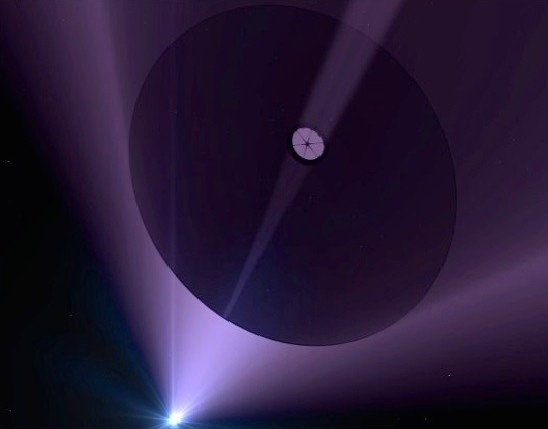By Ana Verayo, | February 23, 2016

Artist's rendition of a laser-propelled interstellar mission.
NASA and other space agencies in the world are all in the race towards the next frontier, which is Mars, as scientists believe that a manned mission to Mars will take six months or more to reach the Red Planet. Now, NASA scientists are now working on this new laser technology that can allow a spacecraft to travel to Mars in a span of just three days.
Like Us on Facebook
This is known as photonic propulsion where simply put, the system generates lasers in order to propel a giant space sail of a spacecraft. Instead of using photons from sunlight, ths system will utilize Earth based laser to boost power.
According to Philip Lubin of the University of California Santa Barbara, there are recent advances in science that are greatly inspired by science fiction as he explains in a video about the concept behind NASA Innovative Advanced Concepts (NIAC), that will use energy propulsion for interplanetary exploration.
He adds how there is no reason why scientists and researchers won't be able to do this, in this new study, relativistic flight can now become possible. This laser system is completely scalable modularly that can be built in any size from a smaller one to a gigantic one.
In this new study, Lubin suggests that this new laser system could work on an ultra thin spacecraft that is fully equipped with integrated optical communications, systems and sensors that are all combined via directed energy propulsion.
He still believes that this new technology will not be immediately utilized for the first manned mission to Mars. Lubin explains that in order to reach the stars and distant galaxies that are located light years away, scientists should be able to radically rethink strategies than wait for technology that still does not exist.
Humans have always dreamed of human spaceflight reaching to the stars and distant alien worlds that have been romanticized in books and movies, however, it is still not within our powers to do so nor is it clear what path to choose to reach it.
This proof of concept grant was given by NASA to Lubin and his team to demonstrate that this new laser system could work, that can send probes to the edges of the solar system.
For example, a 100 kilogram robot spacecraft can reach Mars in a few days using this laser propulsion and if a shuttle would travel via this propulsion system, it can take a month to arrive in Mars. When it comes to Earth-like exoplanets, there are a number that are within 25 light years away which could now be possible to visit along with Alpha Centauri, some four light years away.
-
Use of Coronavirus Pandemic Drones Raises Privacy Concerns: Drones Spread Fear, Local Officials Say

-
Coronavirus Hampers The Delivery Of Lockheed Martin F-35 Stealth Fighters For 2020

-
Instagram Speeds Up Plans to Add Account Memorialization Feature Due to COVID-19 Deaths

-
NASA: Perseverance Plans to Bring 'Mars Rock' to Earth in 2031

-
600 Dead And 3,000 In The Hospital as Iranians Believed Drinking High-Concentrations of Alcohol Can Cure The Coronavirus

-
600 Dead And 3,000 In The Hospital as Iranians Believed Drinking High-Concentrations of Alcohol Can Cure The Coronavirus

-
COVID-19: Doctors, Nurses Use Virtual Reality to Learn New Skills in Treating Coronavirus Patients







